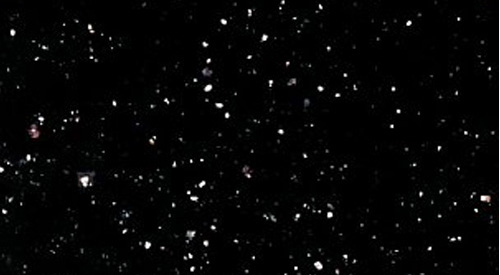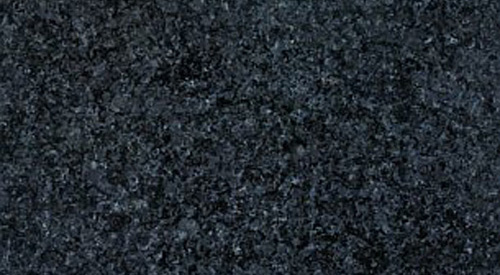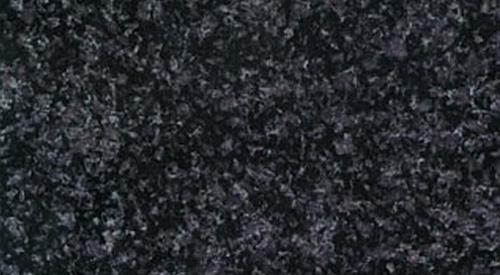The boss's bellowing request "get me some plain black granite" may sound reasonable on the telephone. After all, there are few plain uniformly black limestones fit for an exterior facade; uniform black slate has not the strength specified; both tend not to be colourfast and need exacting fading tests because of their essentially carbonaceous or bituminous pigmentation.
The request, in meantime turned into the demand "blacker than black", triggers off an odyssey encompassing quarries, suppliers, stockyard, testing labs and the like, and modest samples generate into elaborate and time-taking mock-ups.
Not exactly, the scenario for a small order of random cut black granite slabs or tiles. When the order involves monumental structures, with large size slabs, all to be faultlessly black, exposed on four sides to climatic variations, then the search gains momentum. The more so with a delivery time limit for a project, and an anniversary deadline thrown into the bargain.
What is meant by "black granite"?
To quote from the discussion in ASTM C119-95b Standard we learn the following (please take a deep breath!)
"Black Granites: dark-coloured igneous rocks defined by geologists as basalt, diabase, gabbro, diorite and anorthosite are quarried as building stone, building facings, monuments, and speciality purposes and sold as black granite.
The chemical and mineralogical compositions of such rocks are quite different from those of true granites, but black granites nevertheless may be satisfactorily used for some of the same purposes as commercial granite.
They possess an interlocking crystalline texture but, unlike granites, they contain little or no quartz or alkali feldspar.
Instead, black granites are composed dominantly of intermediate to calcic plagioclase accompanied by one or more common dark rock-forming minerals such as pyroxenes, hornblende, and biotite. Such rocks, because of their relatively high content of iron and magnesium, are designated as ferromagnesian or mafic. An exception is anorthosite which, though commonly dark, consists mostly or entirely of calcic plagioclase". So far a statement by consensus. We can now go ahead to use Black Granite as an umbrella term while offering the material under the (geologically correct) names in italics above.
What is in these names is not always clear. Basalt is actually mineralogically a fine-grained gabbro, but is seldom defined as such. The buyer looking for a gabbro is discouraged when the seller is actually offering unwittingly basalt and the buyer moves on to the next supplier. In the same vain Norite is not mentioned in the Standard but is a gabbro with more orthopyroxene than clinopyroxene. This mineralogical surplus may sound natural to the geologist, but makes correct use of scientific names difficult in commercial practice.
The information (in italics) in the Standard is that the mafic iron containing minerals gives the stone its black colour. More specifically the magnetite needles are supplying the deep black in Belfast Black (see below), help the stone consultant in evaluation -all the boss wants is blacker than black.

Until recently, the ASTM discussion was considered informative rather than of normative interest. However with the 'enforcement' of the CEN stone standards with mandatory petrographic description requirements as starting point, these have to be taken seriously. They affect specification, which govern price and quality, both serious items in the industry, besides legal coverage for the buyer and seller.
This is especially true for plain black granites where the grain sizes of the matrix are to be uniform throughout the deposit, causing more often than not the quarry recovery rates (the percentage of marketable material obtained from any volume of material excavated) of less than 5% of the prime material, to the regret of the quarrier. Ideally the grain size of the major constituent,plagioclase, for a fine-grained material should average less than 0.5 mm.
At the end of the slab fabrication, the colour may range from pitch-black (whatever that implies) to darkish grey.
The polished or honed stone may have specks, some causing a glint like in Galaxy Black granite, tiny white spots in any size, shape, colour or shade; may have a brownish, bluish, greenish hue and may be described as deep, dark, medium, light or greyish.

Often a gradual transition from the blacks into the greys takes place at the quarry, calling for selective quarrying to reduce colour variation and increasing extraction costs. Samples for inspection are to be polished on one side and honed on the obverse, even if honed is required, as the true and more lasting colours are brought up by polishing, besides showing any defaults.
With the advent of denomination criteria in the approved CEN Standards the discussion of scientific versus commercial denomination has become hopefully redundant. Just for old times' sake let us look over some denominations of “Black Granites” (or dark greys with an essentially with black matrix). Some of the original names are still being used to indicate varieties. The names in Italics may have become the main appellation, especially by old-timers in the industry.
The classification into categories depend on the petrographical examination (CEN 12407) Standard of random samplings from quarry faces and locations, that may have been changed with the years, and therefore may have turned arbitrary. The categories may even be different for stone within the same working. Anyway, the list is indicative, not exhaustive. Application of CEN 12407 may in good time rectify the situation and a name will be the proper name.
Industrial varieties of black granite
Some of the better known industrial varieties of black granite include:
GABBROS
Belfast Black - Nero Assoluto; SSY Africa; Marlin; Nero Africa (S.A)
Rustenburg Grey (S.A]
Bertania - Noir Royal,Rustenburg Black; Starlight (S.A.)
Impala - Jasberg; Rustenburg
Saari Black (Finland)

MONZODIORITE
Brazil Black- Black Ceara
Ebony Black-Swedish Black ;SS
DIABASE
Finnish Black
Svart EGC; Black EGC (Sweden)
DIORITE
Kuru Black- Kuru Black Star; Tempere (Finland)
Negro Ochavo-Negro Valencia (Spain)
Indian Black-KH Black( India)
Salem Blue (India)
Star Galaxy -Black Galaxy; Galaxy Gold (India)
Zimbabwe Black -Nero Zimbabwe; Belfast Zimbabwe (Africa)
Nero Fine;Nero Coarse;Dark Grey Zimbabwe
Itaoca (Brazil)

DOLORITE
Transkei Black (Transkei)
Kalopa Black (Malawi)
Omenje Dolerite (Namibia)
(Gabbro) - Anorthosite)
Angola Black;Palm Black;Egal Black
The various names in Italics may be typically used in a particular country as e.g. Jasberg and Bertania in Belgium. Each name has some kind of history or anecdote behind it. Bon Accord was named after the Town Square near the block landing point in Aberdeen. When searching for a source of rocks not commonly or widely used in large quantities, like Black Granite, a look at traditional records and applications may help in the final decision, in addition to the recommendations of the supplier.
Quality of black granite
The major, if not traditional, purveyors of black granites are Southern Africa, Scandinavia, Angola, Brazil and these have been joined in the last 30 years by China, India and a host of smaller suppliers.
Extensive technical information is available from South Africa and a short description of the major absolute black at Belfast where production stated in the early 1960s, may be typical for black granite material if not of the geological setting in other parts of the world.
The 'black granite' of Belfast is a dark zone of gabbroic rocks about halfway up in the main plutonic phase of the Bushveld igneous complex. During many decades large tonnage's of dimension stone have been produced and marketed, principally for the monument industry both locally and overseas. Unlike most true granites, the gabbros generally have a very prominent igneous layering closely resembling the bedding of sedimentary rocks.
The gabbro strikes approximately north-south parallel to the general strike of the Bushveld rocks in this area, and dips to the west at about 17 degrees. The zone stretches over a distance of 44 km. The thickness of the zone increases considerably southwards from 175 m in the extreme north to 800 m in the south. Its contacts with the lighter coloured gabbro are not always very sharp, but there is a transition from black to grey. In the southern area, there is an intensely black zone within the dark gabbro.
The Belfast black granite while almost black on polished surfaces, is light grey on a rough one. This is valuable for lettering of memorials because it makes the letters stand out.
According to producers the quality of the rock generally remains the same with depth or may even improve, but the grade often deteriorates with depth. The quality and grade differ from quarry to quarry, but also very within the same quarry.
The best quality at Belfast is generally found along the central portion of the dark gabbro zone. The dark to black colour of the gabbro is due primarily to an abundance of tiny magnetitic needles in the cumulus plagioclase, oriented parallel to its crystallographic directions, with a total of about 8% iron-containing minerals. Often a fairly distinctive fabric parallel to a natural plane of weakness or "freeway" is present This "easy" way greatly facilitates quarrying.
Staying in Africa, Botswana has black diorites, presently quarried for aggregates. Malawi has massive and fine-grained dolerite dykes and Namibia has fine to medium grained dolerites. Tanzania has dykes producing Dodoma Black Granites and Mozambique black granites are awaiting futher development and evaluation.
More recently major quarrying belts are being developed in China and India. In China important supplies come from the Shanxi area and are marketed in several qualities like Mongolian Black, Supreme Black, Nero Assoluto and plainly Shanxi Black. The latter is quarried at Datong with production of 10K cu.m. per year worked between February and October to avoid the severe climate at the 2000m elevation.
India, was put on the black granite producer map when a first major consignment was exported from Dharmapuri to Japan in 1968, following minor sampling lots. Another important event in the promotion of black granite took place when the state organization, Tamil Nadu Minerals, regulated the local black granite trade by setting prices according to quality grading block sizes. The varieties included are dark, medium, light and greyish which again emphasises the fact that black varieties can be less black than the often claimed "blacker" than black.
There are very large deposits of black granites in the states of Tamil Nadu, Karnataka and Andhra Pradesh.The best quality jet black granites come from Kummam, Karsanur, Tindivanam, Paitur, Atur in Tamil Nadu, Charmarjanagar and Kollelgal in Karnataka and Warrangal in Andhra Pradesh.
Other vast black granite deposits exist in the Dharmapuri and Mettur Districts of Tamil Nadu, Chittoor and Khammam in Andhra Pradesh and Kanakpura near Bangalore, where a variety of medium and light medium black granites are found.
Going to the Far East, Shanxi and Shandong in China are principal production centres of many varieties of black granites with names besides the ubiquitous Nero Assoluto like Snow Black, Ji Nan Black, Mongolian Black and many sub-varieties coming from a single quarries under many names and trading establishments.
Amongst the less specialized or smaller black granite suppliers are Brazil which was early in the market with traditional Black Tijuca - Andes Black, a deposit swallowed up by a national park and St.Gabriel Black. Lately some varieties have been offered like Sonic Black. Other countries in Latin America include Suriname, where unexploited black granite dykes spread snakelike over quite large areas; Argentina with some deposits like the La Rioja black at the Andes foothills and, Uruguay where many efforts have been made to market production from their dykes, which even extensive an good quality are of limited thickness.
In Canada, Sweden, and Finland, although possessing large deposits of first class black granites, some quoted in the trade as standards of high quality, are overshadowed by the vast commercial presence of coloured and brighter shaded varieties.
The quality and price of the 'black granite”' are determined by the deepness of colour and grain size of the rock, the darker the rock and the finer the texture the higher the quality and demand. Grade of rough quarry blocks depends on colour and textural qualities, besides the degree of absence of veins, cracks, tiny, and not so tiny, white and clouded spotting etc., whereas in the finished slabs the colour and texture are aesthetic parameters.
Since the main demand calls for the finest possible grain, whether absolute black, or in the matrix of dark greyish varieties like Rustenburg, black granites are more reliable than other granite varieties. This is due to the superior compactness and is born out by the superior test results, all well above International Standard requirements for granites.
Granite quality
A typical quality would have as main physical properties:
African Black/Grey
Spec.Gravity 2.94 g/ cu.cm
Water Absorption 0.08 %
Compressive Strength 265 MPa
With such magnitudes other physical qualities are all but questionable.
Variations in colour and texture in the varieties marketed as "uniform" are rarely acceptable. Being noticeable, deviations from uniformity provide good protection for the buyer, and draw his attention enabling contractual safeguarding. The finer the grain or matrix, the easier to note irregularities, as they stand out, e.g. the "reflector" patches in some varieties or "oil-stains" in others. The petrographic examination usually points out the unstable minerals present in the sample prone to decay, weathering and alteration, leading to activation of some changes in certain environments, and conditions.
Defects found lead sometimes back to the quarry where the weathered part of the deposit or boulders were not decapitated, or the altered crusts not peeled-off sufficiently before squaring the rough blocks for dispatch to the processing plant. Dyke deposits require special attention as quality varies laterally, especially colourwise. In marginal cases, the presence of genetic enrichment in magnetite renders them commercially marketable. On the other hand, appreciable amounts of amphibole and unduly sericitised felspars could dull the polished surface over time. Thorough checking at the quarry before extraction of the ordered saves effort and money both to the suppliers it avoids unnecessary transport and packing, and to the client besides frustration and costly delay of deadlines.
Traditionally the main use of black granite is in tombstones and other monumental items, and to a lesser extent for various types of counters, especially in the financial world, decorative applications, elegant trimmings and luxury floorings.
During the second half of the last century the use of black granite has found a new market for war memorials in displacing in popularity the much different earlier military memorials of mainly white or light colours as e.g. the British War Graves Cemeteries and American Battle Monuments.
Memorials of note include the Vietnam Memorials in Washington, with granite supplied by Oriental Select Granites from quarries in Chamarangar nr. Mysore,Sacramento, and Springfield and the Astronaut Memorial at the Kennedy Space Centre in Florida. The latter used Premier Plus black granite .The Atom Bomb Victims Memorial in Hiroshima is also in black granite.
These specific uses resulted from conflicts and of military actions confirming that wars definitely have an influence on memorial and tombstone fashions. Black granite will remain part of the trend for some time to come, and give the stone industry incentive to develop the quarries diligently as is the case with the other stone producing excavations.
BIBLIOGRAPHY:
1) “Stone in Southern Africa”. Ed. by WR Oosterhuis, co published by UNESCO, IAEG, SADC .ISBN 92-3-103620-3, obtainable at UNESCO PUBLISHING, Paris, 56 pp+ Coloured Plates.
2) “Nordic Stone”. Ed.by Olavi Senonen and Veli Suominen, 2003, UNESCO PUBLISHING, Paris, pp 64.Col. photos in text. ISBN 92-3-103899-0.
These 2 monographs have many bibliographical references to black granite in their resp.areas. Both are obtainable from UNESCO, 7 Place de Fontenoy, 75007, Paris.
